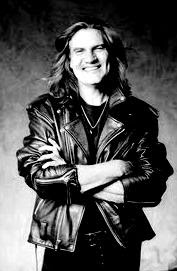Notes:
- During the 1970s, Carl served stints with numerous bands across the Midwest, pausing briefly in 1976 to study piano and refine his songwriting abilities in Oklahoma City. He frequently performed with fellow Midwesterner Tommy Bolin in various jazz/rock fusion groups. By the late-1970s, Carl had graduated to performing on albums by "bigger names," such as Rod Stewart and Dusty Springfield.
Around this time, Carl decided to begin recording as a solo artist. His debut album, Whistling in the Dark was released in 1979 under his given name, Max Gronenthal. A second solo album, Max followed in 1980.
Throughout the 1980s, Carl immersed himself in session work, singing and/or playing on albums by artists such as Elton John, Dan Fogelberg, Bonnie Raitt, Don Henley, Glenn Frey, Timothy B. Schmit, Bette Midler, and Kenny Loggins. In 1982, he also formed a 60s R&B cover band, which was eventually named "Jack Mack and the Heart Attack". This project also incorporated some Max Carl-penned original R&B-styled songs into their repertoire, including the semi-classic "Cardiac Party."
In addition to performing, Carl also found time during the mid-80s to compose tunes for various movie soundtracks, performing on many of them as well. Films such as Police Academy (1984), Grandview, U.S.A. (1984), and Doin' Time (1985) include his compositions. In 1986, he would co-write "Come and Follow Me" as a duet with Marcy Levy, which played during the closing credits of the movie Short Circuit.
Meanwhile, in 1985, Carl left Jack Mack and the Heart Attack to record his third solo album. Unlike the first two solo albums, The Circle would be released under his stage name "Max Carl." The album's title track would be included on the soundtrack for the John Hughes film Weird Science. Later that same year, Carl was invited to join .38 Special, a request that he eventually accepted.
Carl rehearsed with the band frequently, and by 1988, he joined forces with the southern rock stylings of .38 Special. That year, the band would release the Rock & Roll Strategy album, which included the Cal Curtis/Jeff Carlisi tune that was reworked into (giving additional writing credit to Carl) "Second Chance," featuring Carl on lead vocals. "Second Chance" introduced .38 Special into a whole new market, when it reached the top of the Adult Contemporary chart in early 1989. Carl remained in .38 Special into the 1990s, but left shortly after the release of the band's Bone Against Steel album in 1991.
At this point, Carl moved to Nashville, where he continued to write/perform on tunes for the likes of Joe Cocker, Bad Company, Richard Marx, and Charlie Daniels. Later in the 90s, he became fascinated with a "family" of musicians in Mississippi who performed a very original historical and heartland-infused brand of music. Relocating to Mississippi, Carl began performing with this group of musicians, forming what would become Max Carl and the Big Dance. This experience ultimately culminated in the release of the album One Planet – One Groove (under the "Max Carl and the Big Dance" moniker) in 1998. Featured on this album are several of Carl's original compositions fused with this new "southern funk"/"Mississippi sound," as well as covers of various 60s hits done in this style. -
(Notes by http://en.wikipedia.org/wiki/Max_Carl)






0 comentarios:
Post a Comment